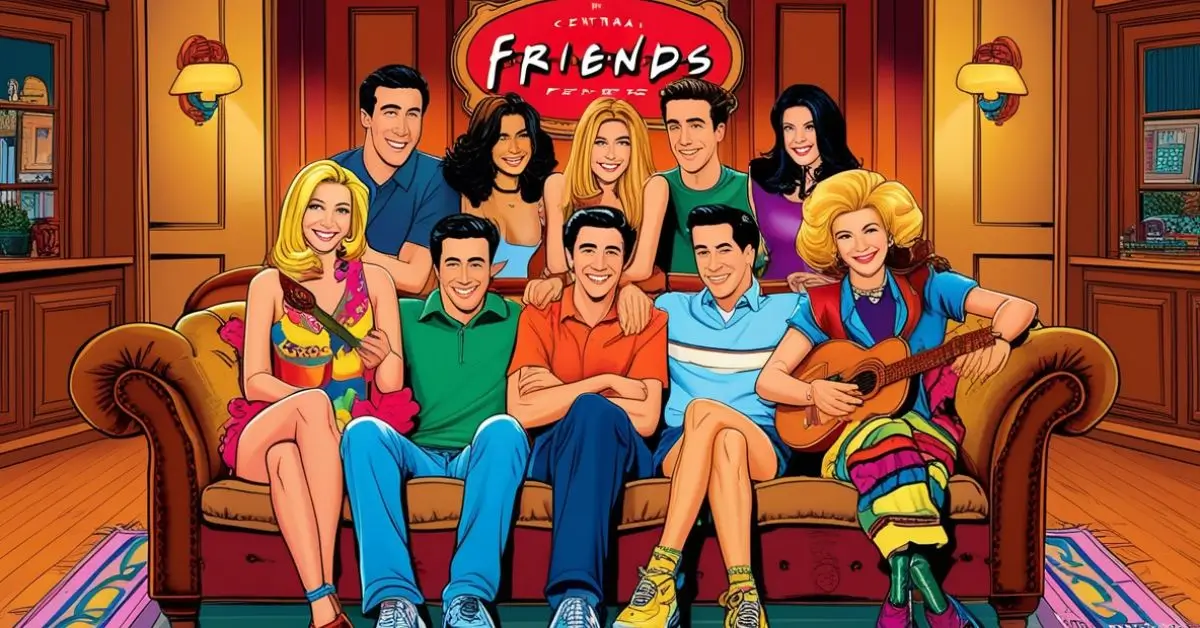When Friends debuted on NBC in 1994, no one could have predicted the massive impact it would have on television and popular culture worldwide. Created by David Crane and Marta Kauffman, the show became an instant sensation, capturing the lives, love stories, and misadventures of six friends navigating young adulthood in New York City. Over its 10-year run, Friends garnered millions of fans, and its influence continues to resonate even decades after the series finale in 2004.
From its unforgettable catchphrases to its iconic character dynamics, Friends remains more than just a sitcom; it’s a cultural phenomenon that redefined how friendship, romance, and humor could be portrayed on television. Let’s explore what makes Friends such a timeless series, delving into its characters, themes, influence, and legacy.
Background and Creation
The story of Friends began in 1993 when David Crane and Marta Kauffman developed an idea based on their experiences in their twenties, navigating life with close friends. Alongside executive producer Kevin S. Bright, they pitched a show initially called Insomnia Café, which then evolved into Friends Like Us and finally, Friends. The show premiered on NBC on September 22, 1994, and aired for a total of 10 seasons, concluding on May 6, 2004.
The series follows six friends—Rachel, Monica, Phoebe, Joey, Chandler, and Ross—through the ups and downs of relationships, careers, and personal growth. Their shared experiences and unbreakable bond became the heart of the show, resonating with viewers who saw parts of themselves in each character. Set primarily in Monica’s apartment and the Central Perk café, Friends created an idealized vision of urban friendship that fans aspired to.
Character Analysis
The strength of Friends lies largely in its diverse, well-developed characters. Each brought something unique to the group, creating a dynamic that allowed for endless comedic and dramatic possibilities.
- Rachel Green (Jennifer Aniston): Originally introduced as a spoiled, privileged young woman, Rachel’s character arc is one of the most significant in the series. Over ten seasons, she transforms into a successful fashion executive, gaining independence and maturity.
- Monica Geller (Courteney Cox): Monica, known for her obsessive cleanliness and competitive nature, is the nurturing heart of the group. A skilled chef and the “mom” friend, Monica struggles with insecurities and family expectations but ultimately finds happiness in her relationship with Chandler.
- Phoebe Buffay (Lisa Kudrow): The quirkiest character, Phoebe is a free-spirited musician with an eccentric backstory. Growing up on the streets after her mother’s tragic death, Phoebe develops a unique perspective on life, bringing warmth and unpredictability to the group.
- Joey Tribbiani (Matt LeBlanc): The lovable actor with a heart of gold, Joey is known for his cluelessness but deep loyalty. His catchphrase, “How you doin’?”, became an iconic part of his character, and his unwavering optimism often lightens the group’s more serious moments.
- Chandler Bing (Matthew Perry): With his self-deprecating humor and sarcasm, Chandler provides some of the series’ most memorable comedic moments. Despite his fear of commitment, he matures throughout the show, particularly through his relationship with Monica.
- Ross Geller (David Schwimmer): Ross, a paleontologist with a tendency toward neurosis, is known for his on-again, off-again relationship with Rachel. His quirky nature and often melodramatic approach to life make him both relatable and endearing.
Together, these characters create a group dynamic that keeps audiences invested, as each episode explores the ups and downs of their lives.
Key Themes and Story Arcs
Friends explores universal themes that connect with audiences, from friendship and romance to career ambitions and personal growth.
- Friendship and Relationships: The central theme of Friends is the importance of friendships, which often serve as the primary support system for each character. The group serves as a chosen family, providing emotional stability amid romantic relationships, heartbreak, and career disappointments.
- Career Aspirations and Struggles: Each character experiences career highs and lows, reflecting the realities of young adulthood. Monica’s struggle to succeed as a chef, Rachel’s journey from waitress to fashion executive, and Joey’s acting challenges highlight the ambition and resilience needed to chase dreams.
- Family Dynamics: Family plays a crucial role in shaping the characters’ personalities and outlooks. Monica and Ross’s sibling rivalry, Chandler’s relationship with his parents, and Phoebe’s complex family history add depth to each character, showing how family relationships can impact friendships and self-perception.
- Life in New York City: The show captures the urban lifestyle, emphasizing both the excitement and challenges of living in a big city. The city itself becomes a character, embodying the energy, dreams, and aspirations of young adults seeking success and happiness.
Humor and Writing Style
Friends is renowned for its clever humor, delivered through witty dialogue, character-driven jokes, and physical comedy.
- Comedy Techniques: The writing style includes sarcasm, wordplay, and irony. Chandler’s sarcastic wit, Phoebe’s unique perspective on life, and Joey’s innocent humor showcase the writers’ skill in developing distinct comedic voices for each character.
- Memorable Quotes and Catchphrases: Lines like “We were on a break!” and “How you doin’?” have become iconic. These quotes add to the humor and have embedded themselves into pop culture, cementing the characters’ voices in fans’ minds.
- Comic Timing and Physical Comedy: The actors bring unique timing to their roles. Moments like Ross’s “Pivot!” during the couch-moving scene, Joey wearing all of Chandler’s clothes, and Chandler’s awkward dancing provide laughs that are still widely appreciated.
Iconic Episodes and Moments
Throughout its 10-season run, Friends produced numerous memorable episodes that fans continue to rewatch and quote.
- Classic Episodes: Beloved episodes include “The One with All the Thanksgivings,” “The One Where Ross Got High,” and “The Last One.” Each episode offers a blend of humor, emotion, and character growth.
- Famous Scenes: Iconic scenes such as Ross’s couch-moving moment (“Pivot!”), the Thanksgiving episodes, and Monica’s proposal to Chandler are emblematic of the show’s ability to mix humor with heartfelt moments.
- Impactful Moments: The show’s more emotional scenes, such as Rachel finding out about Ross’s love, Chandler and Monica’s engagement, and the final scene where the friends leave their keys, resonate deeply with audiences.
Cultural Impact and Legacy
Friends has had an enormous impact on culture, influencing fashion, TV tropes, and language.
- Fashion Influence: Rachel Green’s fashion sense, including the iconic “Rachel” haircut, inspired millions. The characters’ unique styles continue to influence fashion trends.
- Merchandising and Reruns: From DVDs to streaming services like Netflix and HBO Max, Friends is continuously available, allowing new generations to discover it. The availability of Friends merchandise further demonstrates the show’s lasting popularity.
- Global Popularity: The show’s themes are universal, appealing to audiences worldwide. The simplicity and relatability of its premise allow people across cultures to connect with its humor and message.
Criticism and Controversies
Although immensely popular, Friends has faced criticism in retrospect.
- Criticisms: The show has been criticized for its lack of diversity and certain jokes that have not aged well. Some fans argue that the portrayal of women, LGBTQ+ issues, and other social topics could have been handled more sensitively.
- Retrospective Discussions: Despite these critiques, Friends has largely remained beloved. The show’s creators and cast have acknowledged its place in a different era, recognizing the importance of evolving with changing social perspectives.
Reunion Special and Lasting Influence
The Friends reunion in 2021 on HBO Max brought the cast back together, reigniting interest in the series. The special allowed fans to see the actors reflect on their memories and provided insights into the making of the show.
The lasting impact of Friends can be seen in the numerous sitcoms that followed, which have taken inspiration from its themes and character archetypes. Shows like How I Met Your Mother and The Big Bang Theory have borrowed from the Friends formula, further cementing its influence.
Conclusion
In the years since its finale, Friends has maintained an unrivaled place in television history. Through its blend of humor, relatable characters, and emotional storytelling, it captured the hearts of millions and continues to do so. For fans new and old, Friends remains a comfort—a place where, as the theme song says, they’ll “be there for you.” The show is a timeless testament to friendship, love, and the joy of finding a family in those around us.
Friends may be a product of the 90s, but its legacy is timeless, making it an essential part of TV history that will be cherished for generations to come.











